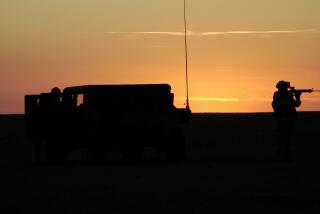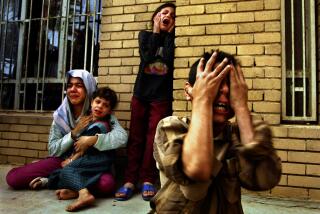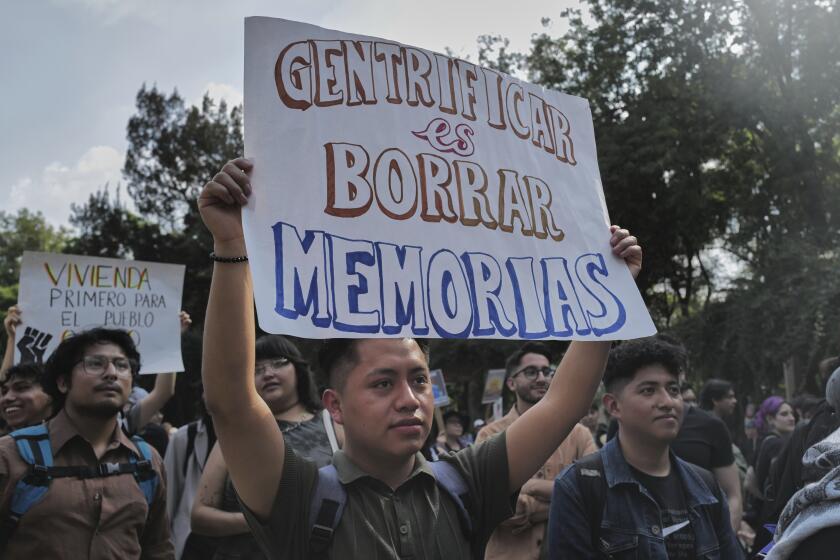The ‘No-War Four’ Finally Gets the Glory
- Share via
Weeks after coalition forces toppled Saddam Hussein’s regime in April, the U.S. Army’s 4th Infantry Division was still camped in Kuwait, waiting to go to war. The graffiti in a desert outhouse summed up the sentiments of many glum soldiers.
“Here we are
For the record:
12:00 a.m. Dec. 18, 2003 For The Record
Los Angeles Times Thursday December 18, 2003 Home Edition Main News Part A Page 2 National Desk 1 inches; 67 words Type of Material: Correction
4th Infantry -- An article in Section A on Monday about the U.S. Army’s 4th Infantry Division incorrectly reported that the last time the division as a whole went into battle was during World War II and that “smaller elements” had fought in Vietnam. Although the division’s three main brigades left for Vietnam at different times, all three were there in the late 1960s and into 1970.
Still in Kuwait
The No-War Four
Has earned its name. Again.”
But because troops from the 4th Infantry and special forces captured Hussein late Saturday near the Iraqi city of Tikrit, the division is enjoying the kind of attention and glory that has gone to other units, time and again, for nearly six decades.
The last time the entire division went into battle was during World War II. Smaller elements fought in Vietnam. But the 4th Infantry has missed out on every war since, and it crossed the “line of departure” into Iraq well after people had begun to speak of the conflict in the past tense -- a premature judgment that changed as coalition soldiers continued to die week after week.
Over the years, grunts and officers alike came to shoulder the 4th Infantry’s reputation -- as the division that couldn’t quite make it to the fight -- with a stiff upper lip, self-deprecating nicknames and gallows humor.
“This is the 4th, man. I’m more likely to get shot by my sergeant than the Iraqis,” a 22-year-old specialist at Camp New Jersey in Kuwait offered last spring as the Army’s 3rd Infantry Division was making headlines with its charge through Iraq and capture of Baghdad.
On Sunday, the 4th Infantry, known as the Iron Horse, was receiving praise from President Bush, British Prime Minister Tony Blair and, perhaps of equal importance to the troops, retired Army Gen. Wesley K. Clark, who is seeking the Democratic Party presidential nomination.
Clark served with the 4th Infantry twice, commanding a battalion and later a brigade.
“It’s an outstanding unit,” he said of the division in a conference call from The Hague, where he was to testify starting today in the war crimes trial of former Yugoslav leader Slobodan Milosevic. “I’m very proud of them.”
At the division’s Iraq headquarters in Tikrit, many soldiers were downright jubilant.
“This is a hell of a glorious day for the 4th ID,” said Spc. Brad Perkins, 37, originally from Rochester, N.Y. “I’m feeling all warm and fuzzy inside.”
The 17,000-member division, based at Ft. Hood, Texas, with one of its brigades stationed at Ft. Carson, Colo., had become the most technologically advanced mechanized unit in the Army by the start of the war in Iraq. Known as the “digitized division,” it boasted hundreds of tanks, Bradley fighting vehicles and Apache attack helicopters outfitted with computers that could track friend and foe on the battlefield in real time.
In planning for the invasion of Iraq, the Pentagon gave the division the task of attacking from Turkey to the north. With their high-tech equipment and a shorter route to Baghdad than the units coming from Kuwait to the south, many soldiers in the 4th Infantry believed they would be the ones to take the Iraqi capital and restore to the division the kind of glory it had not seen since 1944, when it led the D-Day charge on Utah Beach in Normandy, France.
Instead, the Turkish parliament ruled that coalition forces could not use Turkey to launch a ground attack. So the 4th Infantry troops waited in the U.S., and with the division’s equipment floating around the Mediterranean, leaving little to train with, commanding officers gave their soldiers days off. They went fishing, drank beer. One soldier from Ft. Carson broke his leg snowboarding.
After being ordered to Kuwait in March, most of the division’s troops waited in the desert more than a month before entering a conquered Iraq and taking up their post in and around Tikrit, Hussein’s often-hostile hometown. The 4th Infantry has had 41 soldiers killed since its arrival.
Once in the Tikrit area, the division was given one of the key jobs of the occupation: the frustrating but ultimately gratifying task of tracking down Hussein.
We “thought that maybe he’s there, and maybe the 4th ID would get him,” said Lt. Gen. Thomas Metz, whose III Corps includes the division. “That came through today.”
*
(BEGIN TEXT OF INFOBOX)
4th Infantry Division profileDivision facts:
The U.S. Army’s 4th Infantry Division, founded in 1917, served in World War II, and elements of it fought in Vietnam.
Division facts
Soldiers: 17,000
Based: Ft. Hood, Texas
Equipment: The 4th Infantry is known as the ‘digitized division’ for its technological advancement. It is armed with Abrams tanks, Bradley fighting vehicles, howitzers, antitank and anti-armor AH-64 Apache attack helicopters and UH-60 Black Hawk transport helicopters.
Deployment to Iraq: Arrived in Kuwait in late March, rerouted by Turkey’s denial of access to its soil. Division units began entering Iraq on April 12.
Current assignment: Providing security and patrolling areas north of Baghdad, including Kirkuk and Tikrit.
*
Sources: GlobalSecurity.org; CNN
*
Times staff writer Patrick J. McDonnell in Tikrit contributed to this report.
More to Read
Sign up for Essential California
The most important California stories and recommendations in your inbox every morning.
You may occasionally receive promotional content from the Los Angeles Times.












